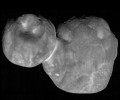Solar System -
Trans-Neptunian Objects
The New Horizons mission was launched on January 19, 2006 on an Atlas V 551 rocket from the Cape Canaveral Air Force Base. It traveled to the dwarf planet Pluto, and its companion Charon, and is now headed into the Kuiper belt. There have been a number of probes to the rocky inner planets, Mercury, Venus and Mars, as well as to the outer gas and ice giants, Jupiter, Saturn, Uranus and Neptune. This is the first mission to the trans-Neptunian region of our Solar System. The New Horizons arrived at the Pluto/Charon/Hydra/Nix/Kerberos system on time on July of 2015.
It passed by Jupiter on February 28, 2007, crossed Saturn's orbit on June 8, 2008, crossed Uranus' orbit on March 18th 2011, and Neptune's orbit on August 25th 2014 before an approach within 6,200 miles of Pluto and 17,000 miles of Charon on July 14, 2015. The Pluto encounter ended in January 2016. The next stop was a small Kuiper Belt object called 2014 MU69 (nicknamed "Ultima Thule"), a journey of almost 1.6 billion km (one billion miles) from Pluto. It arrived there, on time, on January 1st 2019. This was an incredible achievement as the object is only about 32 kms (20 miles) across. There are pictures of this interesting object below.
Although the mission is complete, you can track its continuing progress through the solar system, and, eventually, beyond, at the New Horizons website.
It passed by Jupiter on February 28, 2007, crossed Saturn's orbit on June 8, 2008, crossed Uranus' orbit on March 18th 2011, and Neptune's orbit on August 25th 2014 before an approach within 6,200 miles of Pluto and 17,000 miles of Charon on July 14, 2015. The Pluto encounter ended in January 2016. The next stop was a small Kuiper Belt object called 2014 MU69 (nicknamed "Ultima Thule"), a journey of almost 1.6 billion km (one billion miles) from Pluto. It arrived there, on time, on January 1st 2019. This was an incredible achievement as the object is only about 32 kms (20 miles) across. There are pictures of this interesting object below.
Although the mission is complete, you can track its continuing progress through the solar system, and, eventually, beyond, at the New Horizons website.
New Horizons Mission
Mission Description
High resolution image of Ultima Thule taken during closest approach on Jan 1st, 2019.
Resolution is ~33 meters/pixel.
Credit: NASA
Resolution is ~33 meters/pixel.
Credit: NASA
Images
The New Horizons spacecraft in the clean room prior to launch. The nuclear power source (the "Radioisotope Thermoelectric Generator" ; tthe black device on the left) is a mock-up.
At the time of the launch, Pluto was still classified as the ninth planet in the Solar System before its demotion to dwarf planet status in August of 2006.
Pluto's two small moons Nix and Hydra, both discovered in 2005 shortly before the launch, were given these names to have the same initials as New Horizons, as well as for their relationship to Pluto in mythology. Since the launch, two more small moons, Kerberos and Styx, were discovered in 2011 and 2012, respectively giving Pluto a total of five moons; not bad for a DWARF planet!
Clyde W. Tombaugh discovered Pluto on February 18, 1930, and died in 1997. One ounce of his ashes are on board the spacecraft.
Pluto's name was given by a then eleven year old child named Venetia Burney (later Venetia Phair), who lived in Oxford, UK. An experiment on New Horizons, the Student Dust Counter, is named Venetia after her. She died in 2009. Also, in 1878, it was her maternal great uncle Henry Madan who suggested calling Mars' moons Phobos & Deimos.
Pluto's two small moons Nix and Hydra, both discovered in 2005 shortly before the launch, were given these names to have the same initials as New Horizons, as well as for their relationship to Pluto in mythology. Since the launch, two more small moons, Kerberos and Styx, were discovered in 2011 and 2012, respectively giving Pluto a total of five moons; not bad for a DWARF planet!
Clyde W. Tombaugh discovered Pluto on February 18, 1930, and died in 1997. One ounce of his ashes are on board the spacecraft.
Pluto's name was given by a then eleven year old child named Venetia Burney (later Venetia Phair), who lived in Oxford, UK. An experiment on New Horizons, the Student Dust Counter, is named Venetia after her. She died in 2009. Also, in 1878, it was her maternal great uncle Henry Madan who suggested calling Mars' moons Phobos & Deimos.



